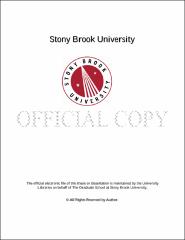| dc.identifier.uri | http://hdl.handle.net/11401/77770 | |
| dc.description.sponsorship | This work is sponsored by the Stony Brook University Graduate School in compliance with the requirements for completion of degree. | en_US |
| dc.format | Monograph | |
| dc.format.medium | Electronic Resource | en_US |
| dc.language.iso | en_US | |
| dc.publisher | The Graduate School, Stony Brook University: Stony Brook, NY. | |
| dc.type | Dissertation | |
| dcterms.abstract | Microphysics and convection parameterizations are two key components in a climate model to simulate realistic climatology and variability of cloud distribution and the cycles of energy and water. When a model has varying grid size or simulations have to be run with different resolutions, scale-aware parameterization is desirable so that we do not have to tune model parameters tailored to a particular grid size. The subgrid variability of cloud hydrometers is known to impact microphysics processes in climate models and is found to highly depend on spatial scale. A scale- aware liquid cloud subgrid variability parameterization is derived and implemented in the Community Earth System Model (CESM) in this study using long-term radar-based ground measurements from the Atmospheric Radiation Measurement (ARM) program. When used in the default CESM1 with the finite-volume dynamic core where a constant liquid inhomogeneity parameter was assumed, the newly developed parameterization reduces the cloud inhomogeneity in high latitudes and increases it in low latitudes. This is due to both the smaller grid size in high latitudes, and larger grid size in low latitudes in the longitude-latitude grid setting of CESM as well as the variation of the stability of the atmosphere. The single column model and general circulation model (GCM) sensitivity experiments show that the new parameterization increases the cloud liquid water path in polar regions and decreases it in low latitudes. Current CESM1 simulation suffers from the bias of both the pacific double ITCZ precipitation and weak Madden-Julian oscillation (MJO). Previous studies show that convective parameterization with multiple plumes may have the capability to alleviate such biases in a more uniform and physical way. A multiple-plume mass flux convective parameterization is used in Community Atmospheric Model (CAM) to investigate the sensitivity of MJO simulations. We show that MJO simulation is sensitive to entrainment rate specification. We found that shallow plumes can generate and sustain the MJO propagation in the model. | |
| dcterms.available | 2017-09-20T16:53:33Z | |
| dcterms.contributor | Zhang, Minghua | en_US |
| dcterms.contributor | Chang, Edmund | en_US |
| dcterms.contributor | Khairoutdinov, Marat | en_US |
| dcterms.contributor | Vogelmann, Andrew | en_US |
| dcterms.contributor | Golaz, Chris | en_US |
| dcterms.contributor | . | en_US |
| dcterms.creator | Xie, Xin | |
| dcterms.dateAccepted | 2017-09-20T16:53:33Z | |
| dcterms.dateSubmitted | 2017-09-20T16:53:33Z | |
| dcterms.description | Department of Marine and Atmospheric Science | en_US |
| dcterms.extent | 103 pg. | en_US |
| dcterms.format | Monograph | |
| dcterms.format | Application/PDF | en_US |
| dcterms.identifier | http://hdl.handle.net/11401/77770 | |
| dcterms.issued | 2017-05-01 | |
| dcterms.language | en_US | |
| dcterms.provenance | Made available in DSpace on 2017-09-20T16:53:33Z (GMT). No. of bitstreams: 1
Xie_grad.sunysb_0771E_13231.pdf: 11411105 bytes, checksum: d5f717b72a87cabc2c99f0831bd8804f (MD5)
Previous issue date: 1 | en |
| dcterms.publisher | The Graduate School, Stony Brook University: Stony Brook, NY. | |
| dcterms.subject | Atmospheric sciences | |
| dcterms.subject | convection parameterization, subgrid inhomogeneity | |
| dcterms.title | Improving and Understanding Climate Models: Scale-Aware Parameterization of Cloud Water Inhomogeneity and Sensitivity of MJO Simulation to Physical Parameters in a Convection Scheme | |
| dcterms.type | Dissertation | |

